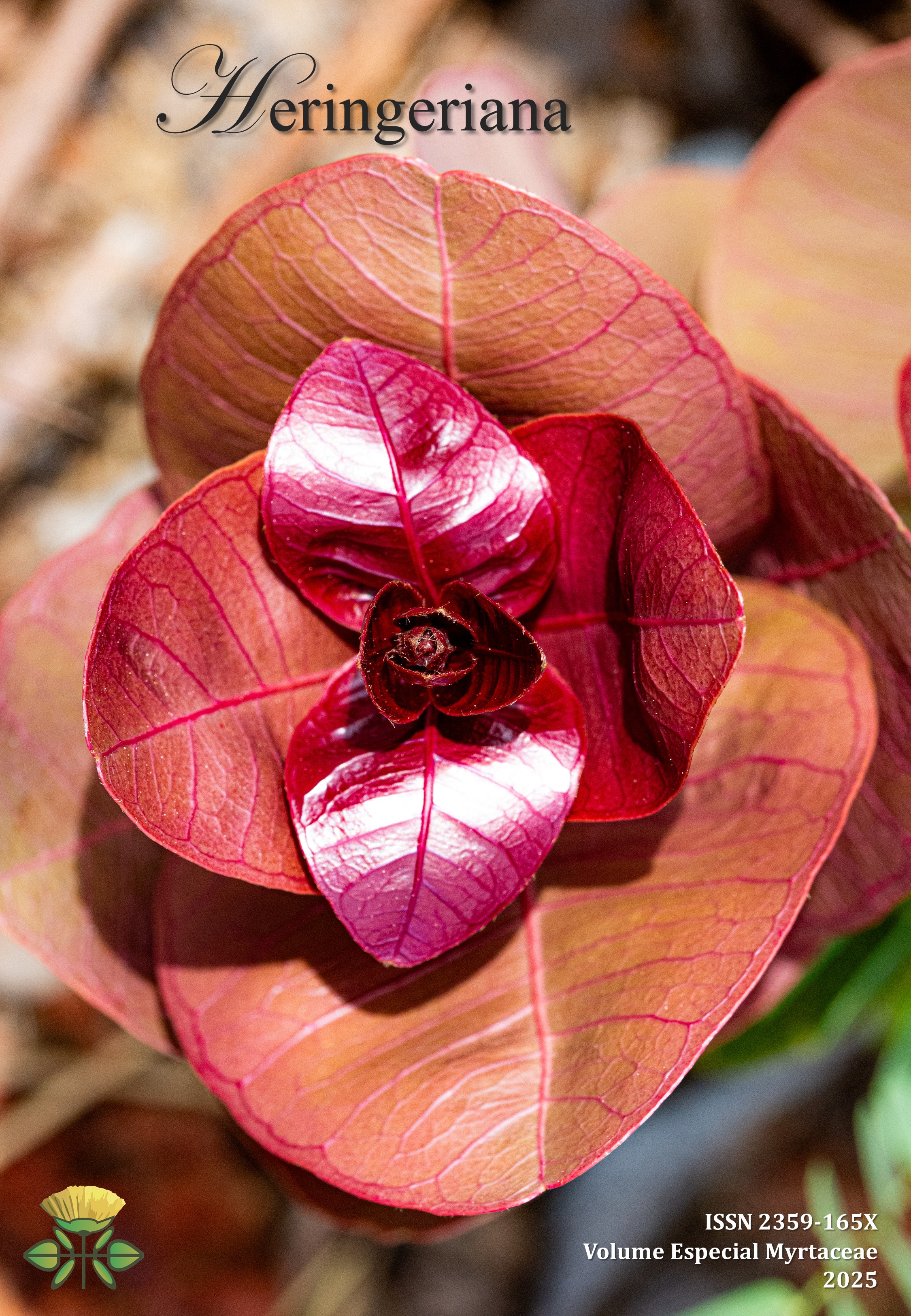Knowledge of Species of Psidium L. (Myrtaceae) in Cerrado Communities of Central Brazil with a History of Migration
DOI:
https://doi.org/10.70782/heringeriana.v19ib.918057Palavras-chave:
urban ethnobotany, tradicional community, ethnobotany, food potencial, fruits, MyrtaceaeResumo
In this work, we sought to investigate the Cerrado biome with emphasis on knowledge of natural resources. The objective was to evaluate the influence of migration on knowledge about species of the genus Psidium by polling informants who lived in different Cerrado regions and later migrated to Brasília, as well as to compare the knowledge of migrants with that of non-migrants from the Quilombola do Cedro Community, located in Mineiros – Goiás. In total, eight Psidium species were recognized by migrant informants and four species were recognized by the non-migrants. Gender, education and age did not influence the migrant informants' knowledge (p>0.05). Non-migrants recognized the complete total resource of Psidium present at the Cedro Community, while the migrants recognized many species, but did not mention species present in communities in which they live. The availability of Psidium to the non-migrant community influenced the knowledge of this genus. From these results it can be suggested that, during the migration process, people incorporated knowledge of known species of the genus Psidium into their repertoire.
Referências
Albuquerque, U. P., & Andrade, L. H. C. (2002). Uso de recursos vegetais da caatinga: O caso do agreste do Estado de Pernambuco (Nordeste do Brasil). Interciência, 27(7), 336–345.
Albuquerque, U. P. (2006) Re-examining hypotheses concerning the use and knowledge of medicinal plants. a study in the Caatinga vegetation of NE Brazil. Journal of Ethnobiology and Ethnomedicine, 2(30), 1–10. https://doi.org/10.1186/1746-4269-2-30
Albuquerque U. P., Ramos, M. A, & Lucena R. F. P. (2014). Methods and techniques used to collect ethnobiological data. In Lucena, R. F. P., & Cunha, L. V. F. C. (Eds). Methods and techniques in ethnobiology and ethnoecology. (pp. 15–37). Springer.
Albuquerque U. P. (2008). Etnobotânica aplicada à conservação da biodiversidade. In Albuquerque, U. P, & Lucena, R. F. P. (org.). Métodos e técnicas na pesquisa etnobotânica. (pp. 227–240). NUPEEA.
Albuquerque, U. P., Cooper, E. L., Medeiros, M. F. T., Alves, R. M. N., & Ladio, A. (2012). Medical Ethnobiology and Ethnopharmacology in Latin America. Hindawi Publishing Corporation.
Alexiades, M. N. (1996). Collecting ethnobotanical data: An introduction to basic concepts and techniques. In Selected guidelines for ethnobotanical research: a field manual. (pp. 53–94). New York Botanical Garden.
Ayres, M., Ayres Júnior, D. L, & Santos, A. A. S. (2007). BioEstat: Aplicações estatísticas nas áreas das ciências biomédicas. Instituto Mamirauá. 364 pp.
Begossi, A., Hanazaki, N., & Tanashiro, J. Y. (2002). Medicinal plants in the Atlantic Forest (Brazil): knowledge use and conservation. Human Ecology, 30(3), 281–299.
Bezerra, J. E. F., Lederman, I. E., Silva Júnior, J. F., & Proença, C. E. B. (2006). Araçá. In Vieira, R. F., Costa, T. S. A., Silva, D. B., Ferreira, F. R., & Sano, S. M. (Eds.). Frutas nativas da região Centro-Oeste do Brasil. (pp. 42–62). Embrapa Recursos Genéticos e Biotecnologia.
Caiado, M. C. S. (2005). Estruturação intra-urbana na região do Distrito Federal e entorno. Revista Brasileira de Estudos de Estudos de População, 22(1), 55–88.
Campos, L. Z. O., Nascimento, A. L. B., Albuquerque, U. P.; Araújo, E. L. (2018). Use of local ecological knowledge as phenology indicator in native food species in the semiarid region of Northeast Brazil. Ecological Indicators, 95, 75–84. https://doi.org/10.1016/j.ecolind.2018.07.016
Ceuterick, M., Vandebroek, I., Pieroni, A. (2007). The use of home- remedies for health care and well-being by Spanish-speaking Latino immigrants in London: A reflection on acculturation. In Pieroni, A., & Vandebroek, I. (Eds.). v. 7. Traveling Cultures and Plants. The Ethnobiology and Ethnopharmacy of Human Migrations. (pp. 145–165). Studies in Environmental Anthropology and Ethnobiology. Berghahn Books.
Crepaldi, M. O. S., Peixoto, A. L. (2007). Use and knowledge of plants by “Quilombolas” as subsidies for conservation efforts in an area of Atlantic Forest in Espírito Santo State, Brazil. Biodiversity and Conservation, 19, 37–60. https://doi.org/10.1007/s10531-009-9700-9
Costa, I. R., & Forni-Martins, E. R. (2006). Chromosome studies in Brazilian species of Campomanesia Ruiz et Pavón and Psidium L. (Myrtaceae Juss.). Caryologia, 59, 7–13. https://doi.org/10.1080/00087114.2006.10797891
Figueiredo, G. M., Leitão–Filho, H. F., Begossi, A. (1993). Ethnobotany of Atlantic Forest coast communities Diversity of plant uses in Gamboa (Itacuruçá Island, Brazil). Human Ecology, 21(4), 419–430.
Florentino, A. T. N., Araújo, E. L., & Albuquerque, U. P. (2007). Contribuição de quintais agroflorestais na conservação de plantas da Caatinga, Município de Caruraru, PE, Brasil. Acta Botanica Brasilica 21(1), 34–37. https://doi.org/10.1590/S0102-33062007000100005
Franzon, R. C., Campos, L. Z. de O., Proença, C. E. B. & Sousa-Silva, J. C. (2009) Araçás do Gênero Psidium: principais espécies, ocorrência, descrição e usos. (pp. 1–47). Embrapa Cerrados.
Goedert, C. O. (2007). História e avanços em recursos genéticos no Brasil. In Nass, L. L. (Ed.) Recursos genéticos vegetais. (pp. 23–60). Embrapa Recursos Genéticos e Biotecnologia.
Guarim Neto, G., & Morais, R. G. (2003). Recursos medicinais de espécies do cerrado de Mato Grosso: um estudo bibliográfico. Acta Botanica Brasilica, 17(4), 561–584.
Hanazaki, N. (2003). Comunidades, conservação e manejo: papel do conhecimento ecológico local. Biotemas, 16(1), 23–47.
IdBrasil. (2010). Projeto Comunidades Quilombolas.(http://www.idbrasil.org.br/drupal/?q=node/19). Accessed: 16 May 2010.
Kristensen, M., Baslev, H. (2003). Perceptions, use and availability of woody plants among the Gourounsi in Burkina Faso. Biodiversity and Conservation, 12(8), 1715–1739. https://doi.org/10.1023/A:1023614816878
Lee, R. A., Balick, M. J., Ling, D. L., Sohl, F., Brosi, B. J., & Raynor, W. (2001). Cultural dynamism and change: An Example from the Federated States of Micronesia. Economic Botany, 55(1), 9–13. https://www.jstor.org/stable/4256387
Leite, S. 2003. Assentamentos rurais: impactos locais e geração de emprego (http://www.comciencia.br/reportagens/agraria/agr11.shtml)
Lins Neto, E. M. F., Peroni, N., Albuquerque, U. P. (2010). Traditional knowlwdge and Manegement of Umbu (Spondias tuberose, Anarcadiaceae): An endemic species from semi-arid region of Northeastern Brazil. Economic Botany, 64(1), 11–21. https://doi.org/10.1007/s12231-009-9106-3
Lozada, M., Ladio, A. & Wigandt, M. (2006). Cultural Transmission of Ethnobotanical Knowledge in a Rural Community of Northwestern Patagonia, Argentina. Economic Botany, 60(4), 374–385. https://doi.org/10.1663/0013-0001(2006)60[374:CTOEKI]2.0.CO;2
Luoga, E. J., Witkowski, E. T. F., Balkwill, K. (2000). Differential utilization and ethnobotany of trees in Kitulanghalo Forest Reserve and surrounding communal lands, Eastern Tanzania. Economic Botany, 54(3), 328–343. https://www.jstor.org/stable/i389500
Maciel, M., & Guarim-Neto, G. (2006). Um olhar sobre as benzedeiras de Jurema (Mato Grosso, Brasil) e as plantas usadas para benzer e curar. Boletim do Museu Paraense Emílio Goeldi, Ciências Humanas, 2(3), 61–77.
Medeiros, P. M., Almeida, L. S., Lucena, R. F. P, de., & Albuquerque, U. P. (2008). The role of visual stimuli in ethnobotanical surveys: An overview. In Albuquerque, U. P., & Ramos, M. A. (Eds.) Current Topics in Ethnobotany (pp. 125–137). Research Signpost.
Miranda, T. M., Hanazaki, N. (2008). Conhecimento e uso de recursos vegetais de restinga por comunidades das Ilha do Cardoso (SP) e de Santa Catarina (SC), Brasil. Acta Botanica Brasilica, 22, 203–215. https://doi.org/10.1590/S0102-33062008000100020
Monteiro, J. M., Albuquerque, U. P., Lins-Neto, E. M. F., Araújo, E. M., & Amorim, E. L. C. (2006). Use patterns and
knowledge of medicinal species among two rural communities in Brazil’s semi-arid northeastern region. Journal of Ethnopharmacology, 105, 173–186. https://doi.org/10.1016/j.jep.2005.10.016
Myers, N., Mittermeier, R. A., Mittermeier, C. G., Fonseca, G. A. B., & Kent, J. (2000). Biodiversity Hotspots for Conservation Priorities. Nature, 403, 853–858. https://doi.org/10.1038/35002501
Ososki, A. L., Balick, M. J., Daly, D. C. (2007). Medicinal plants and cultural variations across Dominican rural, urban and transnational landscapes. In Pieroni, A. & Vandebroek, I., (Eds.) Traveling Cultures and Plants: The Ethnobiology and Ethnopharmacy of Human Migrations. (pp. 14–38). Berghahn Brooks.
Parron, L. M., Sousa-Silva, J. C., & Camargo, A. J. A. (1998). Reservas ecológicas da Embrapa Cerrados: caracterização e zoneamento. 1ª ed. 76 p. Embrapa Cerrados.
Pieroni, A. (2003). Wild food plants and Arberesh women in Lucania, Southern Italy. In Howard, P. (Ed.), Women and Plants: Case Studies on Gender Relations in Biodiversity Management and Conservation. (pp. 66–82). Sed Press.
Pieroni, A., Muenz, H., Akbulut, M., Baser, K. H., Durmuskahya, C. (2005). Traditional phytotherapy and trans-cultural pharmacy among Turkish migrants living in Cologne, Germany. Journal of Ethnopharmacology, 102, 69–88. https://doi.org/10.1016/j.jep.2005.05.018
Pieroni, A., & Quave, C. (2005). Traditional pharmacopeias and medicines among Albanians and Italians in southern Italy: A comparison. Journal of Ethnopharmacology, 101, 258–270. https://doi.org/10.1016/j.jep.2005.04.028
Pieroni, A., Vandebroek, I. (2007). Traveling Cultures and Plants. The Ethnobiology and Ethnopharmacy of Human Migrations. Studies in Environmental Anthropology and Ethnobiology. v. 7. 294 p. Berghahn Books.
Proença, C. E. B., Oliveira, R. S. and A.P. Silva. (2000). Flores e frutos do cerrado. 226 p. Editora Universidade de Brasília/Imprensa Oficial do Estado de São Paulo.
Queiroz, E. P. (2006). A migração intra-metropolitana no Distrito Federal e Entorno: o conseqüente fluxo pendular e o uso dos equipamentos urbanos de saúde e educação. XV Encontro Nacional de Estudos Populacionais. Caxambú, MG.
Ramos, M. A., Medeiros, P. M., Almeida, A.L.S., Patriota, A.L., Albuquerque, U.P. (2008). Can quality justify
local preferences for firewood in area of caatinga (dryland) vegetation. Biomass and Bioenergy, 32, 503–509. https://doi.org/10.1016/j.biombioe.2007.11.010
Reyes-Garcia, V. V., Vadez, S., Tanner Mcdade, T., Huanca, E. W., D. Leonard., Wilkie, D. (2005). Knowledge and consumption of wild plants: a comparative study in two Tsimane’ villages in the Bolivian Amazon. Ethnobotany Research and Applications, 3, 201–207.
Ribeiro, J. F.; Walter, B. M. T. 2008. As principais fitofisionomias do bioma Cerrado. In Sano, S. M., Almeida, S. P., & Ribeiro, J. F. (Eds.), Cerrado: ecologia e flora. (pp. 153–212). Embrapa Cerrados. 406p.
Rossato, S. C., Leitão Filho, H., Begossi, A. (1999). Ethnobotany of Caiçaras of the Atlantic Forest Coast (Brazil). Economic Botany, 53(4), 387–395. https://doi.org/10.1007/BF02866716
Sá e Silva, I. M. M., Maragon, L. C., Hanazaki, N. &Albuquerque, U.P. (2009). Use and knowlwdge of fuelwood in three rural caatinga (dryland) communities in NE Brazil. Environment, Development and Sustainability, 11, 833–852. https://doi.org/10.1007/s10668-008-9146-3
Santos, L. L., Ramos, M. A., Silva, S. I., Sales, M. F. & Albuquerque, U. P. (2009a). Caatinga Ethnobotany: Anthropogenic Landscape Modification and Useful Species in Brazil's Semi-Arid Northeast. Economic Botany, 63, 1–12. https://doi.org/10.1007/s12231-009-9094-3
Santos, K. L., Peroni, N., Guries, R.P., Onofre, N.R. (2009b). Traditional Knowledge and Management of Feijoa (Acca sellowiana) in Southern Brazil. Economic Botany, 63, 204–214. https://doi.org/10.1007/s12231-009-9076-5
Silva, V. A., Albuquerque, U. P. & Nascimento, V. T. (2008). Técnicas para análise de dados etnobotânicos. (pp. 127–144). In Albuquerque, U. P., Lucena, R. F. P., & Cunha, V. F. C. (Eds). Métodos e Técnicas na Pesquisa Etnobotânica. Editora Livro Rápido/NUPEEA.
Silva, C. P., & Proença, C. E. B. (2008). Uso e disponibilidade de recursos medicinais no município de Ouro Verde de Goiás, GO, Brasil Acta Botanica Brasilica, 22(2), 481–492. https://doi.org/10.1590/S0102-33062008000200016
Sobral, M., Proença, C., Souza, M., Mazine, F., & Lucas, E. (2010). Myrtaceae in Lista de Espécies da Flora do Brasil. Jardim Botânico do Rio de Janeiro. (http://floradobrasil.jbrj.gov.br/2010/FB010863)
Sokal, R. R., & Rholf, F. G. (1995). Biometry. Freeman and Company.
Taita, P. (2003). Use of woody plants by locals in Mare aux Hippopotamus biosphere reserve western Burkina Faso. Biodiversity and Conservation, 12, 1205–1217. https://doi.org/10.1023/A:1023045316329
Viu, A. F. M., Campos, L. Z. O., Viu, M. A. O., & Santos, C. S. (2007). Etnobotânica e preservação do bioma Cerrado no município de Jataí-GO. Revista Brasileira de Agroecologia, 2(2), 1282–1286.
Voeks, R. A., & Leony, A. (2004). Forgetting the forest: Assessing medicinal plant erosion in Eastern Brazil. Economic Botany, 58, 294–306. https://doi.org/10.1663/0013-0001(2004)58[S294:FTFAMP]2.0.CO;2
Volpato, G., & Godinez, D. (2004). Ethnobotany of Pru, a traditional Cuban refreshment. Economic Botany, 58(3), 381–395. https://doi.org/10.1663/0013-0001(2004)058[0381:EOPATC]2.0.CO;2
Volpato, G., Godinéz, D., Beyra, A., Barreto, A. (2009a). Migration and ethnobotanical practices: the case of Thifey among Haitian immigrants in Cuba. Human Ecology, 37, 43–53. https://doi.org/10.1007/s10745-008-9211-4
Volpato, G., Godinéz, D., Beyra, A., Barreto, A. (2009b). Uses of medicinal plants by Haitian immigrants and their descendants in the Province of Camaguey, Cuba. Journal of Ethnobiology and Ethnomedicine, 5(16), 1–9. https://doi.org/10.1186/1746-4269-5-16
Zar, J. H. (1996). Bioestatistical Analysis. Prentice-Hall. (718 p).
Downloads
Publicado
Como Citar
Edição
Seção
Licença
Copyright (c) 2025 Letícia Zenóbia de Oliveira Campos, Jair Eustáquio Quintino de Faria Júnior, Ulysses Paulino Albuquerque, Carolyn Elinore Barnes Proença

Este trabalho está licenciado sob uma licença Creative Commons Attribution 4.0 International License.
Ao fazer a submissão, os autores declaram não ter submetido o trabalho a outra revista e concordam em ter seu artigo publicado sob Licença Creative Commons Atribuição 4.0 Internacional BY (CC BY 4.0), que significa que os autores mantêm a propriedade dos direitos autorais, mas qualquer pessoa pode usar o conteúdo publicado, desde que os autores originais e a fonte sejam citados. O conteúdo científico, ortográfico e gramatical é de total responsabilidade dos autores.








